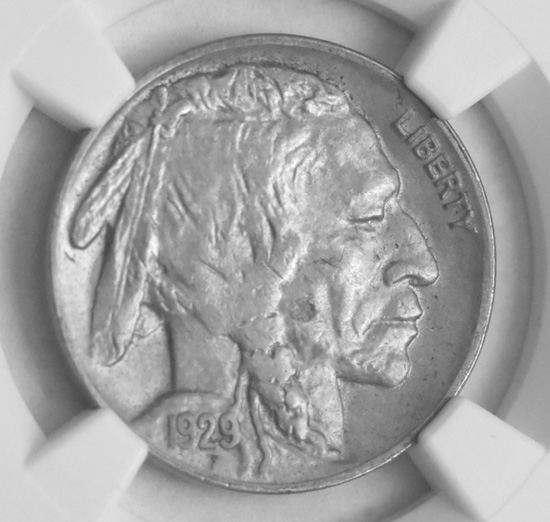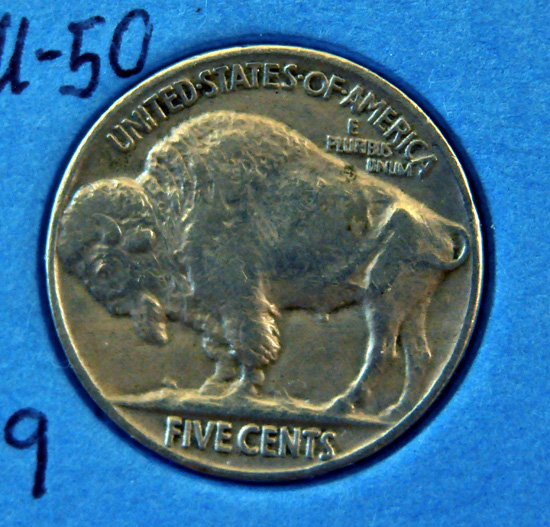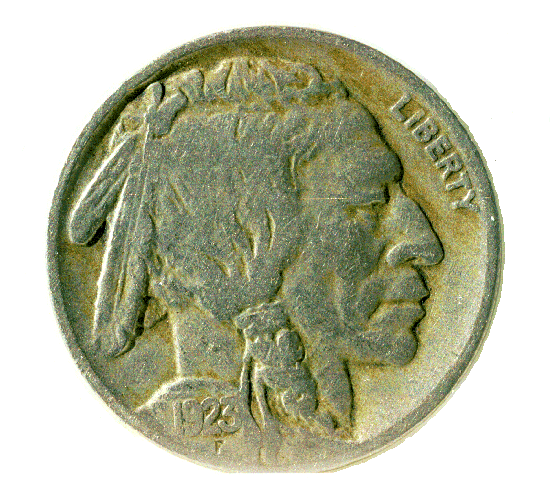Buffalo Nickel
1913 Variety I
1913 to 1938 Variety II
 |
What has been described as the most dramatic, artistic, and original design for a U.S. coin was introduced in 1913 for the nickel. History records that the designer, James E. Fraser, hired an Indian to sit for the obverse portrait and took his sketching gear to the Bronx Zoo to obtain a likeness of a buffalo for the reverse side of the coin. If there is a criticism to be found it is that the design promoted even the slightest amount of wear quickly and few persons other than collectors ever saw the coin at its best. The first coins minted in 1913 had the words 'FIVE CENTS' printed on the raised gound under the buffalo (variety I) but this was soon changed to place them under the raised ground. (variety II). It is interesting that the coin name comes from the reverse side. The popularity of this coin was immense and it eventually came to be known by its reverse: the Buffalo Nickel. With the exception of a few double strike events and one other unusual issue, most years were produced in large quantities and only a few issues from the San Francisco mint are worth more than average value. The unusual event occurred in Denver in 1937. For some unknown reason, a small number of these coins were struck in that year with the buffalo standing on only three legs. This issue has become a collector’s favorite and is worth hundreds to thousands of dollars, depending upon the condition. It should be noted that this coin is often counterfeited by erasure of one of the animal’s legs. The rarest Buffalo nickel is the 1913 S variety II, of which only 1,209,000 were minted. |
 |
| This is an AU 58 coin that I recently bought for the D case. It cost me $44.85 and is only worth about $40 but these days, with taxes and shipping, it is nearly impossible to buy a coin for a total of its actual value. | This is the obverse of the coin at left. | |
 |
|
 |
| This is the reverse of a 1925 example in fine condition that I own - it cost $1.25 and is worth $3.50 The coin was sold as an AU 50 but I think it is more likely an EF 40 or EF 45. I now have a complete set of these coins. | This is the obverse side of the nickel and is of a 1923 example I own - despite the obvious wear, it is in fine condition. |
1923: February 5: United States v. Bhagat Singh Thind: The Supreme Court decides that Bhagat Singh Thind cannot become a naturalized U.S. citizen because, as a Punjabi Sikh, he is not a "white person". March 23: The governor of Oklahoma signs House Bill 197 with the Montgomery amendment outlawing the theory of evolution in public school textbooks purchased by the state, the first anti-Darwinian legislation passed in the U.S. May 27 – The Ku Klux Klan defies a law requiring publication of its members. September 4: The United States Navy’s first home-built rigit airship USS Shenandoah makes her first flight at Naval Air Station Lakehurst (New Jersey); she contains most of the world's extracted reserves of helium at this time. September 17: 1923 Berkeley Fire: A major fire in Berkeley, California erupts, consuming some 640 structures, including 584 homes in the densely built neighborhoods north of the campus of the University of California. October 15: The New York Yankees defeat the New York Giants, 4 games to 2, to win their first World Series Title. October 16: Roy and Walt Disney found The Walt Disney Company. Undated: Rainbow trout introduced into the upper Firehole River in Yellowstone National Park. |